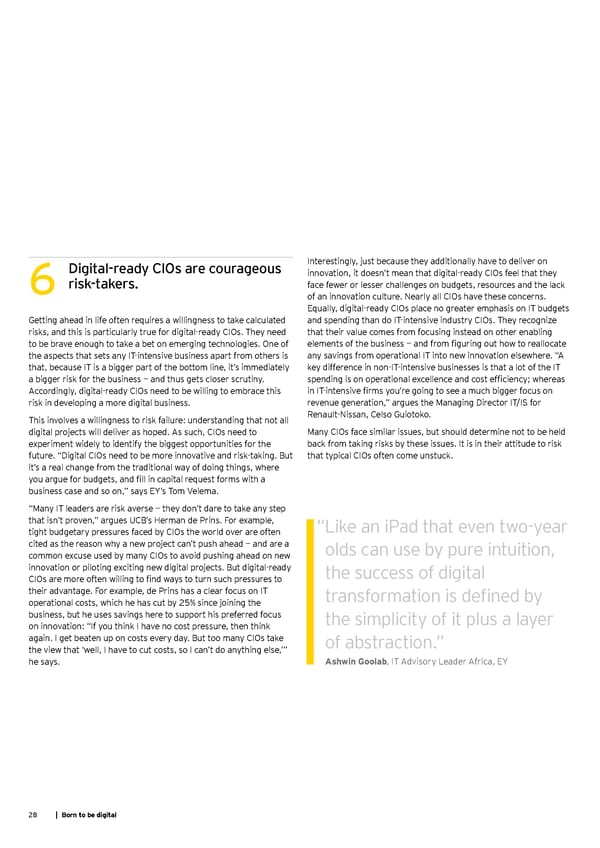Digital-ready CIOs are courageous Interestingly, just because they additionally have to deliver on innovation, it doesn’t mean that digital-ready CIOs feel that they 6risk-takers. face fewer or lesser challenges on budgets, resources and the lack of an innovation culture. Nearly all CIOs have these concerns. Equally, digital-ready CIOs place no greater emphasis on IT budgets Getting ahead in life often requires a willingness to take calculated and spending than do IT-intensive industry CIOs. They recognize risks, and this is particularly true for digital-ready CIOs. They need that their value comes from focusing instead on other enabling to be brave enough to take a bet on emerging technologies. One of elements of the business — and from figuring out how to reallocate the aspects that sets any IT-intensive business apart from others is any savings from operational IT into new innovation elsewhere. “A that, because IT is a bigger part of the bottom line, it’s immediately key difference in non-IT-intensive businesses is that a lot of the IT a bigger risk for the business — and thus gets closer scrutiny. spending is on operational excellence and cost efficiency; whereas Accordingly, digital-ready CIOs need to be willing to embrace this in IT-intensive firms you’re going to see a much bigger focus on risk in developing a more digital business. revenue generation,” argues the Managing Director IT/IS for This involves a willingness to risk failure: understanding that not all Renault-Nissan, Celso Guiotoko. digital projects will deliver as hoped. As such, CIOs need to Many CIOs face similar issues, but should determine not to be held experiment widely to identify the biggest opportunities for the back from taking risks by these issues. It is in their attitude to risk future. “Digital CIOs need to be more innovative and risk-taking. But that typical CIOs often come unstuck. it’s a real change from the traditional way of doing things, where you argue for budgets, and fill in capital request forms with a business case and so on,” says EY’s Tom Velema. “Many IT leaders are risk averse — they don’t dare to take any step that isn’t proven,” argues UCB’s Herman de Prins. For example, “ Like an iPad that even two-year tight budgetary pressures faced by CIOs the world over are often cited as the reason why a new project can’t push ahead — and are a olds can use by pure intuition, common excuse used by many CIOs to avoid pushing ahead on new innovation or piloting exciting new digital projects. But digital-ready the success of digital CIOs are more often willing to find ways to turn such pressures to their advantage. For example, de Prins has a clear focus on IT transformation is defined by operational costs, which he has cut by 25% since joining the business, but he uses savings here to support his preferred focus the simplicity of it plus a layer on innovation: “If you think I have no cost pressure, then think again. I get beaten up on costs every day. But too many CIOs take of abstraction.” the view that ‘well, I have to cut costs, so I can’t do anything else,’” he says. Ashwin Goolab, IT Advisory Leader Africa, EY 28 | Born to be digital
 Born to be Digital Page 32 Page 34
Born to be Digital Page 32 Page 34